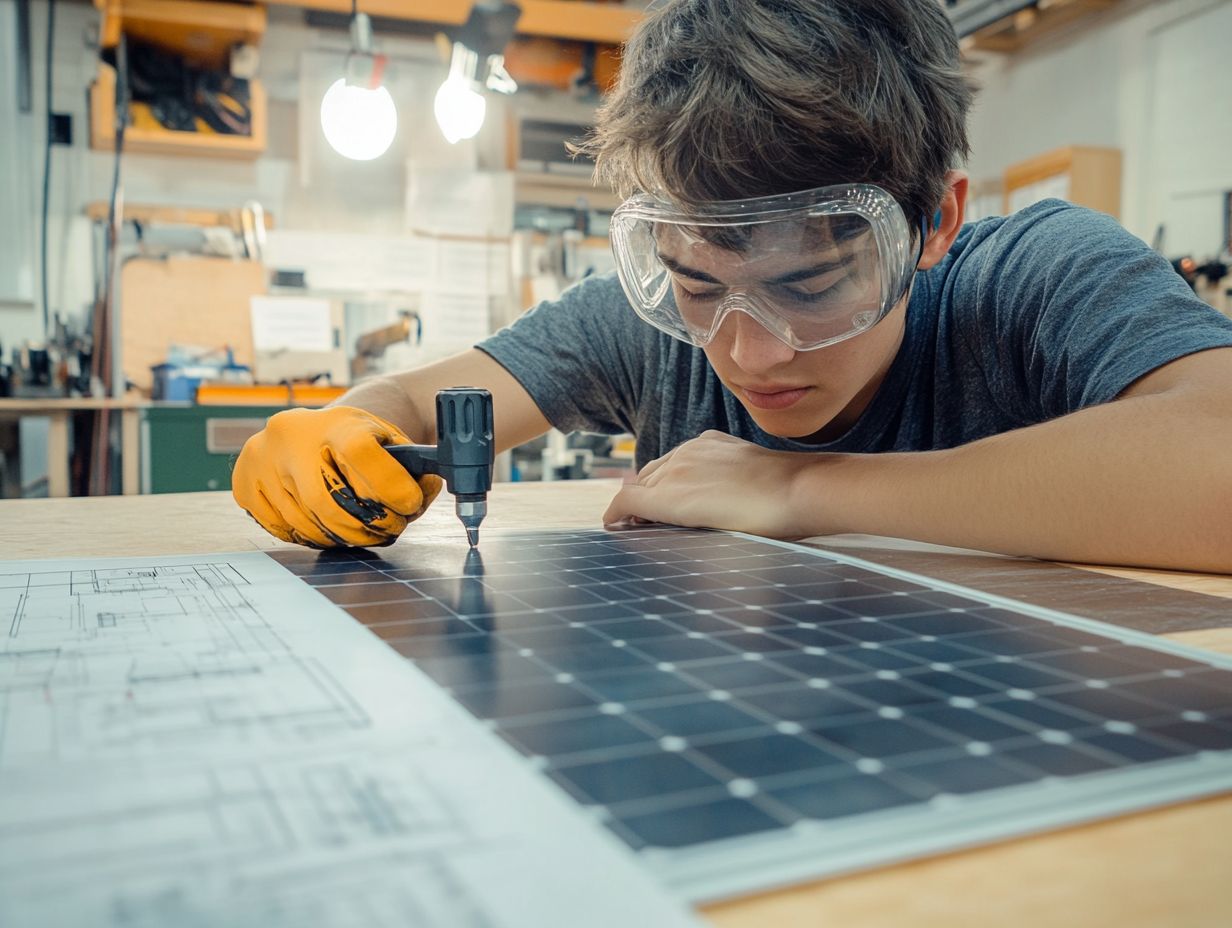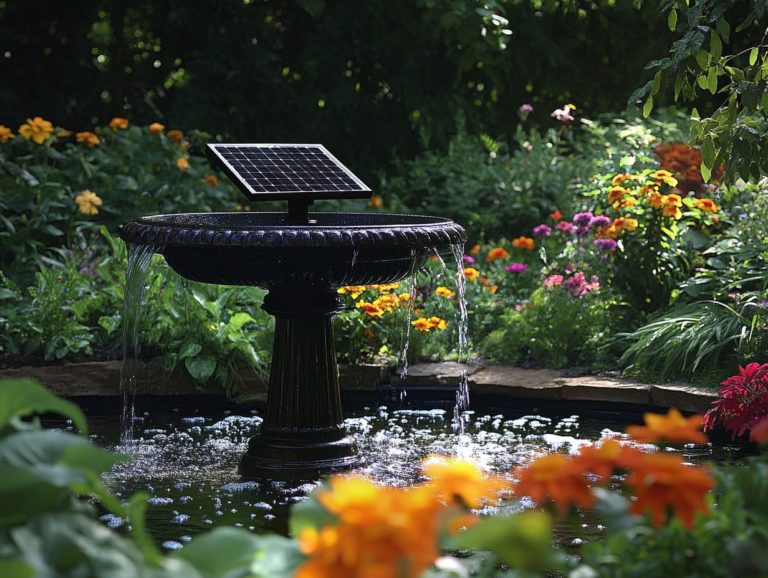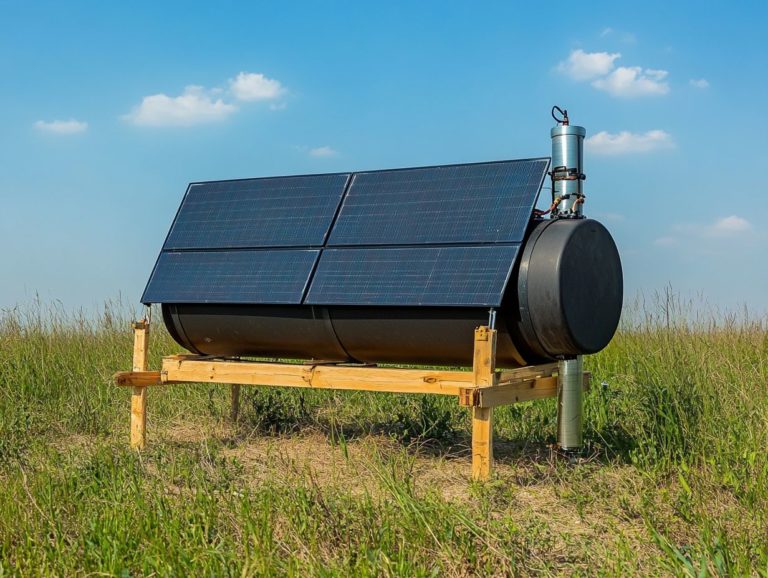Guidelines for Building Your Own Solar Panel
Solar energy is rapidly emerging as a favored option for those who are eco-conscious and eager to minimize their carbon footprint while cutting down on energy costs.
This guide delves into the intricacies of solar panels, showcasing the multitude of benefits associated with constructing your own solar power system. It outlines the essential materials and tools you’ll need for the project, ensuring you’re well-equipped to embark on this DIY solar project journey.
Get ready to harness the sun s energy! You’ll find a step-by-step approach to assembling your solar panel, along with tips to maximize its efficiency and crucial solar panel safety precautions to keep in mind. Whether you’re a DIY enthusiast or simply curious about renewable energy, this comprehensive solar installation guide is designed to empower you to harness the sun’s power for your own sustainable energy needs. Start your journey towards energy independence now!
Contents
- Cost Savings and Environmental Benefits
- Materials and Tools Needed
- Step-by-Step Guide to Building a Solar Panel
- Assembly and Wiring
- Tips for Maximizing Efficiency
- Positioning and Maintenance
- Safety Precautions
- Frequently Asked Questions
- What are the basic guidelines for building your own solar panel?
- What materials are needed for building a solar panel?
- Do I need any special skills or knowledge to build a solar panel?
- Are there any safety precautions I should take when building a solar panel?
- Can I save money by building my own solar panel?
- Are there any other benefits to building your own solar panel?
Key Takeaways:

- Building your own solar panel can save you money and benefit the environment through the use of renewable energy sources, ultimately leading to significant electric bill savings.
- Essential materials and tools needed for building a solar panel include solar cells, a soldering iron, and a multimeter, all of which are critical solar panel components.
- Proper positioning and maintenance of your solar panel can help maximize its efficiency, while taking necessary safety precautions is important for a safe installation process.
Understanding Solar Energy
Grasping the fundamentals of solar energy is essential for anyone thinking about living more sustainably, especially through the implementation of DIY solar panels.
Solar energy captures sunlight and converts it into electricity, offering an environmentally friendly alternative to conventional power sources. By educating yourself on the workings of solar power, you can make informed decisions regarding your energy consumption, thereby contributing to a cleaner environment while reaping significant savings.
With a plethora of solar energy solutions at your fingertips, including readily available solar panel kits, embarking on this journey toward being able to generate your own renewable energy and achieving significant solar energy savings has never been more accessible.
How Solar Panels Work
Solar panels function by transforming sunlight into electricity through photovoltaic cells, the special cells that convert sunlight into electricity, which are essential components that significantly influence the efficiency of the entire system.
These photovoltaic cells are typically crafted from silicon, a semiconductor that reacts dynamically to sunlight. When light photons strike the cells, they dislodge electrons from their atoms, creating a flow of electricity. The flow of electricity is captured and channeled through conductive materials, such as metal frames and wiring, which are integral to the overall design.
The performance of solar panels depends on several factors, including the quality of the cells, the angle at which they are installed, and the application of anti-reflective coatings that enhance sunlight absorption. By optimizing these elements, solar panels can generate greater energy output, positioning themselves as a compelling choice for sustainable energy solutions.
Benefits of Building Your Own Solar Panel
You can enjoy many advantages when you build your own solar panels, including significant savings on solar energy and electric bills. This makes it a worthwhile investment for homeowners looking to enhance their energy efficiency.
By embarking on a DIY solar project, you not only gain valuable hands-on experience, but you also play a crucial role in renewable energy production and move closer to achieving energy independence.
Overall, building your own solar panel is a smart choice for your wallet and the planet.
Cost Savings and Environmental Benefits
The cost savings associated with DIY solar projects go well beyond just the installation phase. You ll enjoy significant solar energy savings and electric bill savings, along with the long-term benefits of reduced energy bills. Not to mention, you’ll have a positive environmental impact by harnessing renewable energy sources!
While investing in DIY solar systems may require an upfront expense, this initial cost is often balanced by generous rebates and solar energy incentives available to homeowners. This makes it an increasingly appealing option for you.
As you harness the power of the sun, you’ll notice a gratifying reduction in your monthly utility bills while contributing to a decline in carbon emissions. Making this shift promotes a healthier environment and makes a difference!
Your DIY solar projects can pay for themselves through the energy savings you achieve. If you’re wondering how to start with solar panels, these initiatives empower you and your community by fostering energy independence and resilience against fluctuating energy prices.
Materials and Tools Needed

To successfully embark on your DIY solar project, it s crucial to gather the right materials and tools. This includes selecting solar panel kits equipped with all the essential equipment, solar energy cells, and electrical components needed to streamline the construction process.
Essential Components and Equipment
The essential components and equipment you need for solar panel construction include key elements like solar energy cells, appropriate wiring for electrical connections, and specialized tools to ensure everything is assembled correctly. This equipment is crucial for the success of your DIY solar project.
Beyond these primary items, your solar setup will typically feature a robust frame that supports the entire assembly and shields it from the elements. A junction box is another crucial component; it enables safe and efficient electrical connections, ensuring a smooth flow of electricity generated by the solar energy cells.
To optimize energy efficiency, an inverter is essential; it transforms the direct current produced by the cells into alternating current, making it suitable for your home appliances. Lastly, proper mounting hardware is essential to secure the entire system, providing stability and the perfect angle for maximum solar absorption. If you’re interested in harnessing solar energy effectively, consider creating homemade solar heating panels.
Step-by-Step Guide to Building a Solar Panel
This guide discusses various solar system types, including grid-tie systems, hybrid solar systems, and off-grid solar systems. Choose the best option for your needs.
A comprehensive solar installation guide is essential if you’re considering a DIY solar project. It offers clear, step-by-step instructions for the entire solar panel construction process, guiding you from gathering materials to the final installation of the solar panels. If you’re particularly interested in solar water systems, check out this guide on how to build your own solar water heater.
Preparing the Materials
Preparing the materials for your DIY solar project is about gathering the essential solar panel components and tools you ll need for effective construction. Ensuring that everything is at your fingertips before you dive into assembly is key.
This crucial step streamlines the entire process and helps you sidestep frustration later on. Start by establishing an organized workspace where every component is easily accessible—think solar panels, inverter, charge controller, batteries, wiring, and the necessary tools like soldering irons and multimeters. For those looking to enhance their setup, learning how to build a battery bank for solar energy can be incredibly beneficial. Consulting a structural engineer can also be beneficial for ensuring the stability of your installation.
Using labeled containers or bins can be a lifesaver, keeping those smaller items from disappearing into the abyss. It s wise to prepare a checklist to ensure nothing slips through the cracks. By systematically laying out your materials and tools, you ll save time and dramatically enhance your overall project efficiency.
Assembly and Wiring
The assembly of your solar panel system involves connecting various electrical components. Ensure everything is wired correctly for a fully functional setup. Using a solar installation guide can provide detailed steps for efficient assembly.
To get started, gather all the necessary tools and materials, including connectors, wires, and a multimeter for testing your connections. Begin by securely mounting the solar panels in a location that enjoys ample sunlight throughout the day. Once positioned, connect the solar panels following the manufacturer’s instructions, carefully matching positive to positive and negative to negative terminals. If you’re interested in renewable energy projects, consider learning how to make your own solar oven for an innovative approach.
Safety should be your top priority. Don your gloves and goggles to shield against potential electrical shocks or injuries. It s also crucial to use weather-resistant wiring to prevent damage from the elements and protect your system.
After connecting the panels, move on to wiring the charge controller and batteries. Ensure that all connections are tight and secure, paying attention to proper polarity. For those interested in DIY projects, learning how to build your own solar-powered battery charger can enhance your understanding. Make it a habit to regularly check your connections and system performance to maintain efficiency and catch any potential issues before they escalate.
Tips for Maximizing Efficiency

To get the most out of your solar panels, maximizing their efficiency is key. By doing so, you not only enhance the benefits of solar energy but also improve the overall performance of your panels. Following solar panel DIY tips can help you achieve the best results from your solar energy system.
This strategic approach reduces the need for frequent maintenance, allowing you to enjoy the advantages of solar power with greater ease and effectiveness.
Positioning and Maintenance
The proper positioning of solar panels is crucial for optimizing their efficiency, while regular maintenance ensures that your system consistently delivers peak solar power output over time. Understanding solar panel manufacturing processes helps you select high-quality panels for your installation.
You need to meticulously calculate the angle and direction of your solar panels to harness the maximum sunlight throughout the day, especially with the seasonal variations in sun exposure. For those in the northern hemisphere, a south-facing orientation is typically recommended for optimal performance. If you’re interested in more details, check out this guide on how to create a simple solar charger.
Keeping your panels clean and free from debris is essential; dirt and grime can impede light absorption and reduce energy production. Regular inspections are key as they help identify potential issues like shading from overgrown trees and ensure that your inverter systems are operating efficiently. Additionally, if you’re interested in maximizing your energy efficiency, consider exploring how to construct a DIY solar air heater.
By implementing a well-planned maintenance routine, you not only prolong the lifespan of your panels but also maximize your return on investment. This approach makes solar energy a sustainable choice that pays off for years to come.
Safety Precautions
When embarking on a DIY solar project, prioritizing safety precautions is absolutely essential. Working with electrical components carries risks, so equip yourself with safety goggles and check your local building permits to stay safe and legal.
Taking these steps not only protects you but also enhances the overall success of your project.
Important Considerations for Safe Installation
Embarking on your DIY solar panel installation journey? It’s crucial to handle electrical components safely, ensure proper structuring, and secure the necessary building permits.
These elements minimize risks and lead to a smoother installation. Evaluate your roof’s structural integrity to support the weight of the solar panels, considering potential weather conditions.
Consult professionals for guidance on connecting the electrical system. Improper handling can cause dangerous issues like short circuits or fires.
Securing local building permits meets legal requirements and enhances the safety and effectiveness of your solar energy system. With thorough preparation and best practices, you can dramatically improve the reliability and longevity of your installation.
Frequently Asked Questions
What are the basic guidelines for building your own solar panel?

The basic guidelines for building your own solar panel include selecting suitable materials, planning the design, understanding electrical components, ensuring proper insulation, and following safety protocols.
What materials are needed for building a solar panel?
To build a solar panel, you will need solar cells, a backing material, a frame, a junction box, wires, and a glass cover. Depending on your design, you may require additional materials.
Do I need any special skills or knowledge to build a solar panel?
Basic DIY skills and some knowledge of electrical components are helpful. However, anyone can build a solar panel with the right instructions and materials, thanks to the many online resources and tutorials available.
Are there any safety precautions I should take when building a solar panel?
Yes, safety precautions are vital when building a solar panel. Wear protective gear like gloves and goggles, and be aware of electrical hazards. Follow proper wiring and insulation techniques to prevent accidents.
Can I save money by building my own solar panel?
Yes, creating your own solar panel can be cost-effective compared to purchasing one. However, consider the initial costs of materials and the effort involved in building it yourself.
Are there any other benefits to building your own solar panel?
Building your own solar panel allows you to customize the design and size to fit your needs. It also provides a better understanding of solar panels and the satisfaction of creating a sustainable energy source for your home or project.






